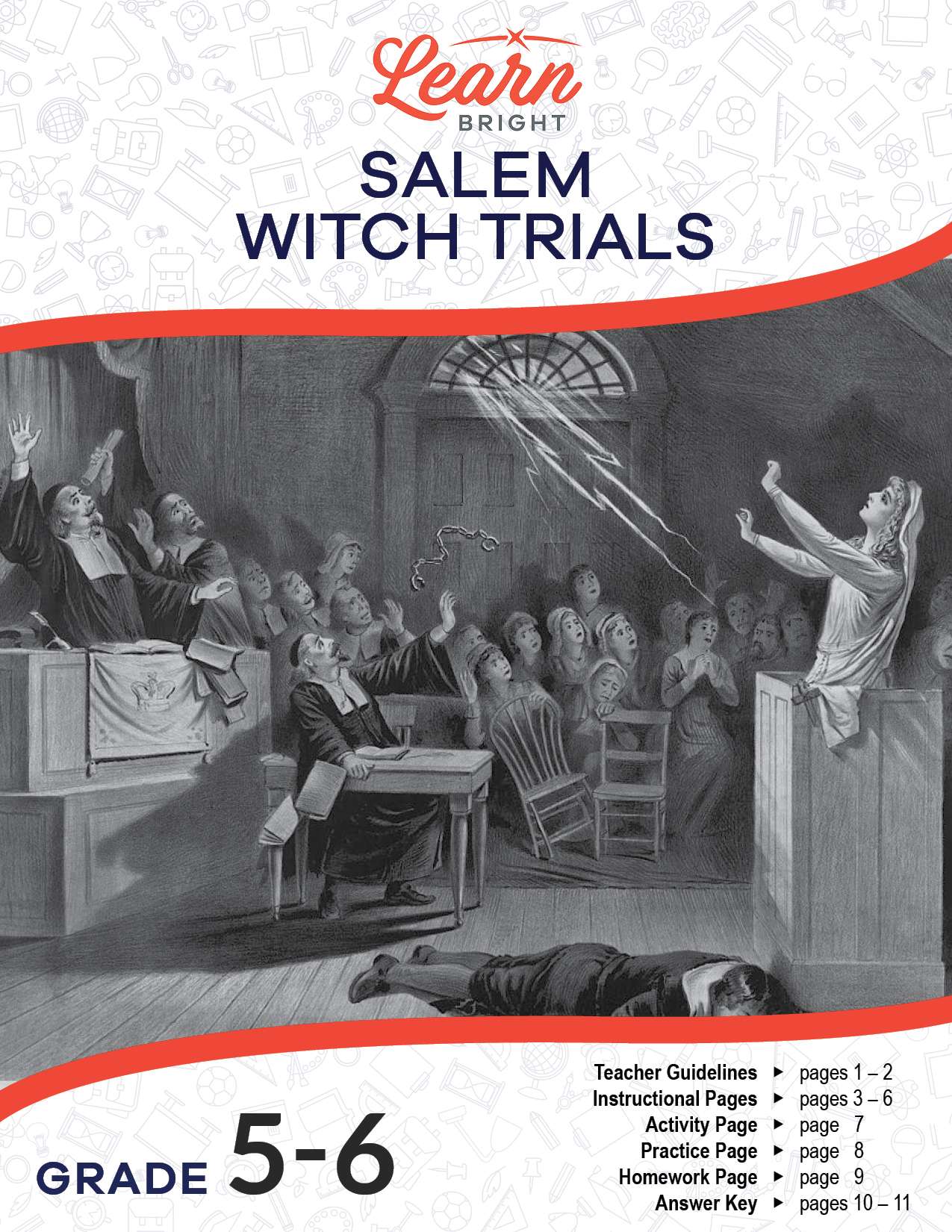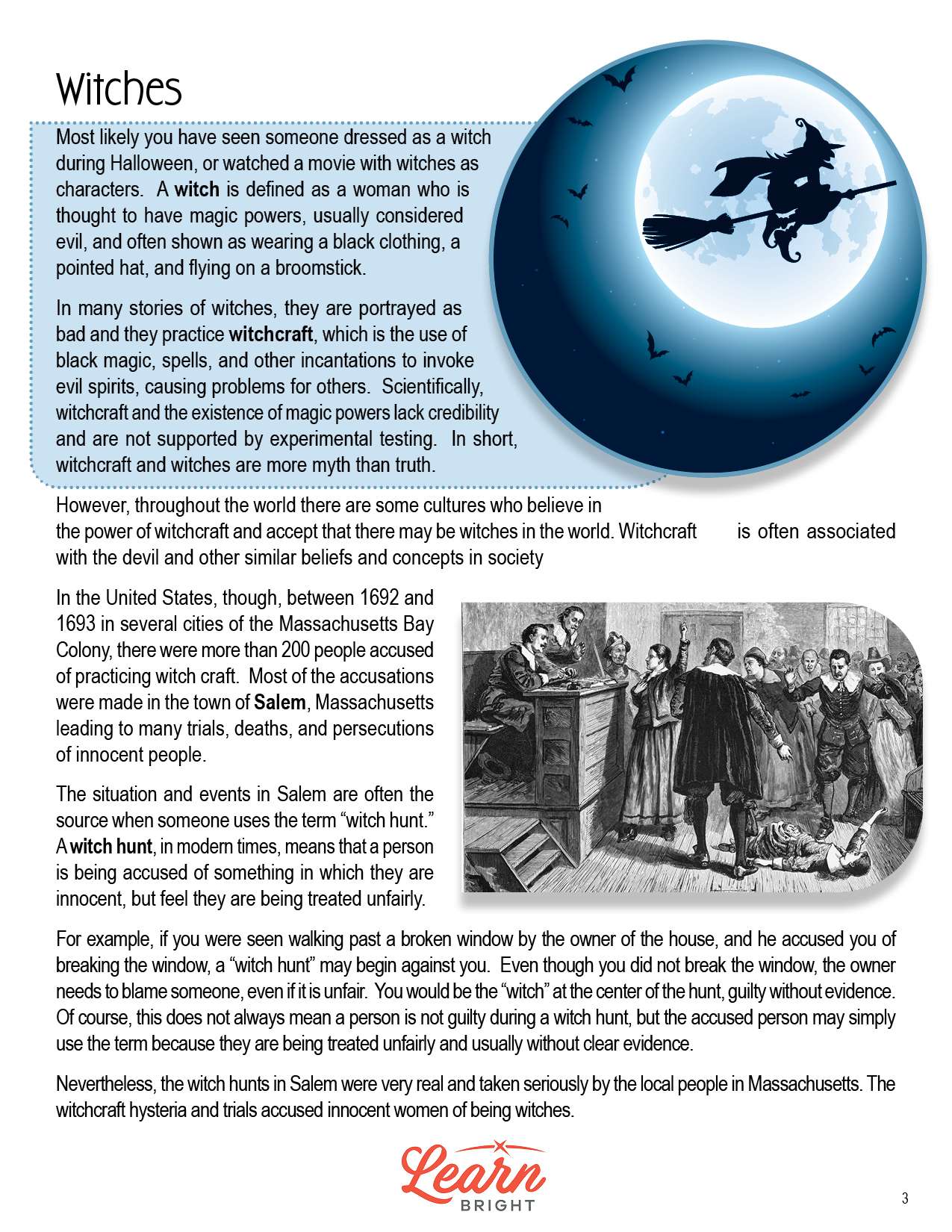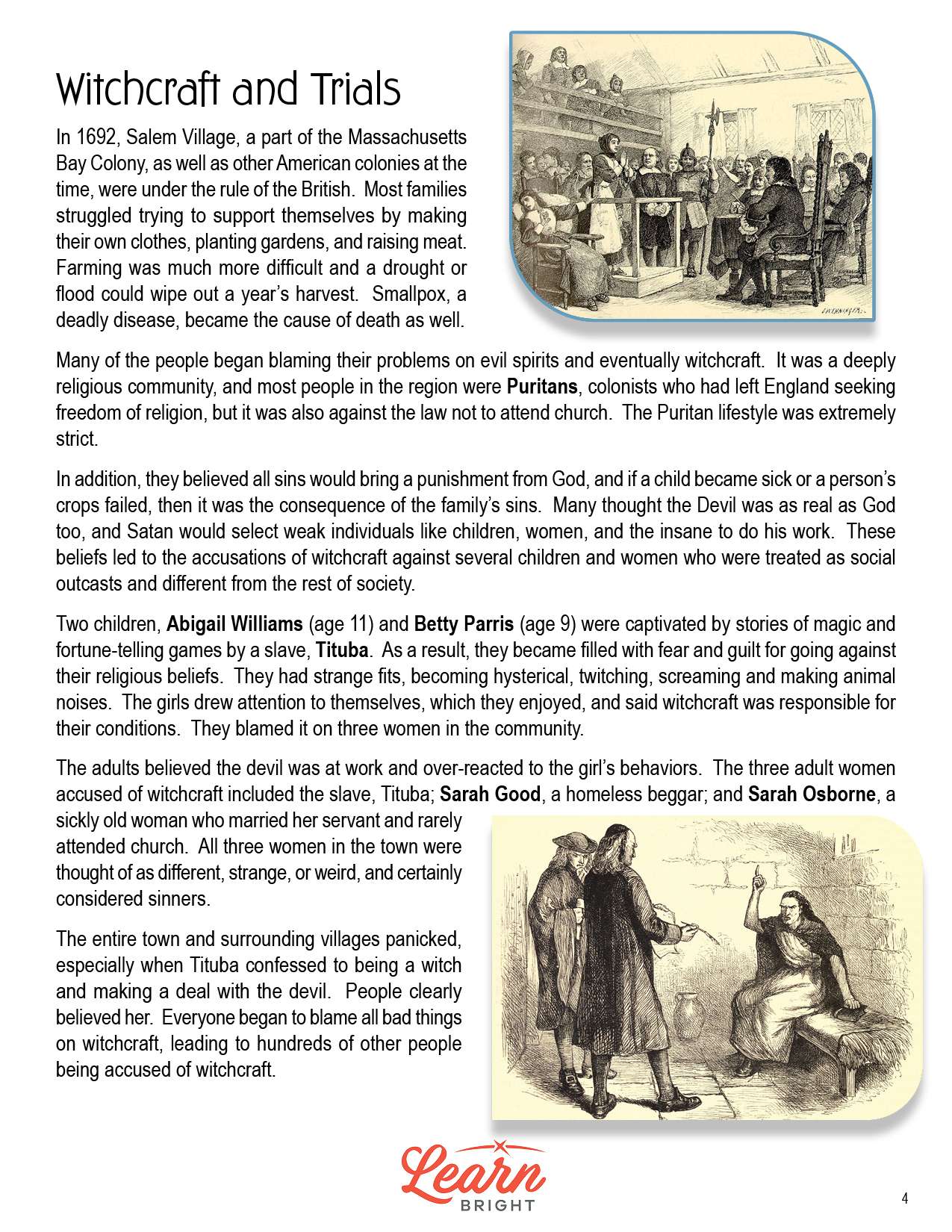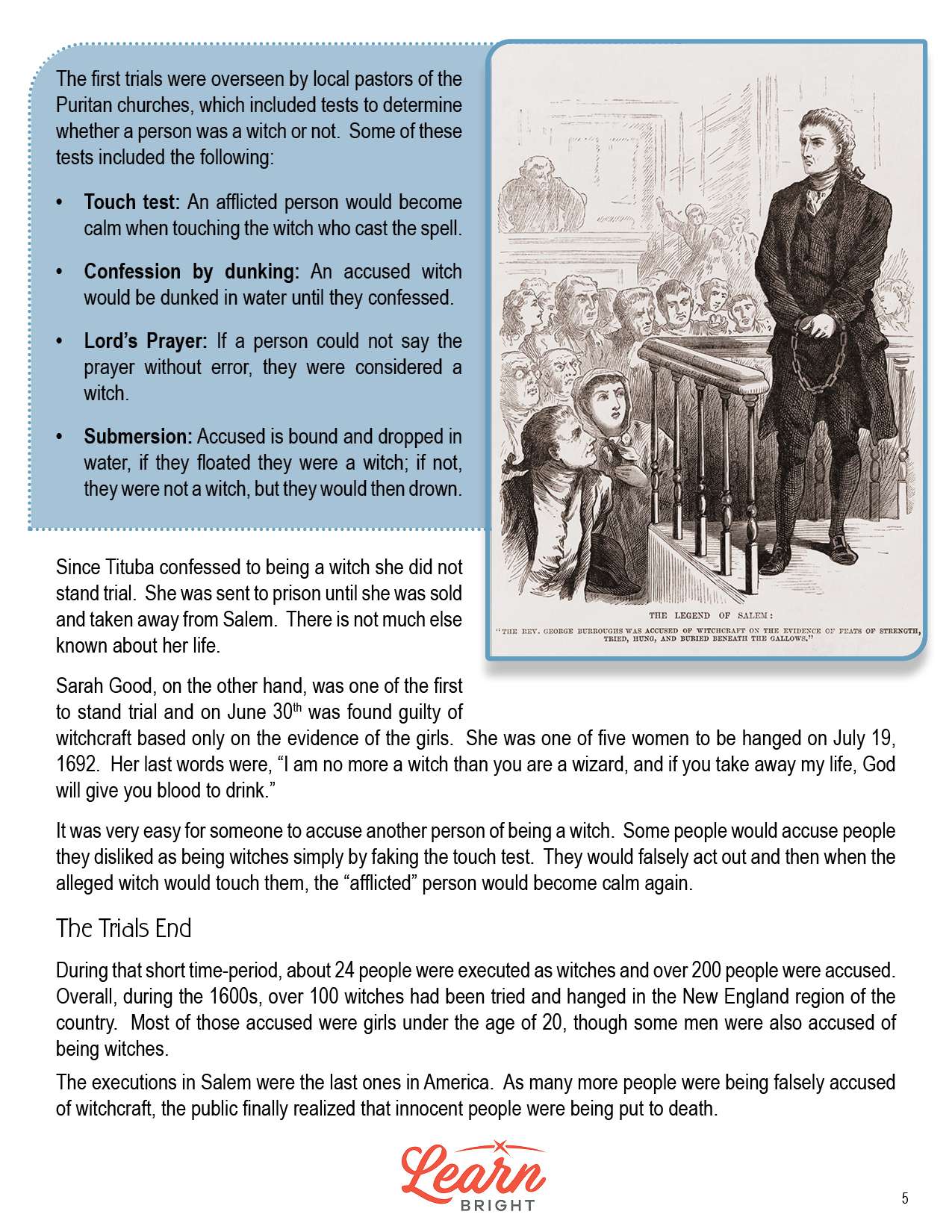Description
What our Salem Witch Trials lesson plan includes
Lesson Objectives and Overview: Salem Witch Trials lesson plan introduces students to the Salem Witch Trials and the hysteria that went along with them. Many students have heard the term “witch hunt” but may not understand the history or background of its use. At the end of the lesson, students will be able to define and describe the Salem Witch Trials, identify participants, and explain the hysteria behind the trials, including their influence on society. This lesson is for students in 5th grade and 6th grade.
Classroom Procedure
Every lesson plan provides you with a classroom procedure page that outlines a step-by-step guide to follow. You do not have to follow the guide exactly. The guide helps you organize the lesson and details when to hand out worksheets. It also lists information in the orange box that you might find useful. You will find the lesson objectives, state standards, and number of class sessions the lesson should take to complete in this area. In addition, it describes the supplies you will need as well as what and how you need to prepare beforehand. The only supplies you will need for this lesson is paper for “Front Page” news stories.
Options for Lesson
Included with this lesson is an “Options for Lesson” section that lists a number of suggestions for activities to add to the lesson or substitutions for the ones already in the lesson. One optional addition to the lesson activity is to combine the “Front Page” stories into a single newspaper to be available to the class. You could conduct your own Salem Witchcraft Trial where you assign students as Pastors, judges, witches, townspeople, and more. You could also have your students research the history of witchcraft prior to the 1600s in America. One other idea is to have students develop new methods or tests to determine if a person is a witch. Finally, you can have students research modern alleged witch hunts taking place in politics, entertainment, or in other areas of society.
Teacher Notes
The teacher notes page includes a paragraph with additional guidelines and things to think about as you begin to plan your lesson. This page also includes lines that you can use to add your own notes as you’re preparing for this lesson.
SALEM WITCH TRIALS LESSON PLAN CONTENT PAGES
Witches
The Salem Witch Trials lesson plan includes four content pages. Most people have seen other people dressed as a witch for Halloween or in a movie. Witches are women who are thought to have magic powers, are considered evil, and are portrayed wearing black clothing, a pointed hat, and flying on a broomstick.
Many stories portray witches as bad people who practice witchcraft, or the use of black magic, spells, and other incantations to do evil or cause problems for other people. Witchcraft has no basis in science and witches do not actually exist. They are myths.
However, in the past and throughout the world, some cultures believed in the power of witchcraft. They often associated witches with the devil and other similar concepts.
Between 1692 and 1693 in the Massachusetts Bay Colony in the United States, they accused more than 200 people of practicing witchcraft. Most of these accusations came from the town of Salem. This led to many trials, deaths, and the persecution of innocent people.
This situation and others like it gave us the phrase “witch hunt,” which we still use today. Today, we us the term witch hunt to describe when someone accuses someone else of something in which they are innocent. People treat them unfairly.
If you walked past a broken window, for example, and the owner of the building accused you of breaking it, the owner may be starting a witch hunt against you. You didn’t break the window, but the owner feels like they need to blame someone with no evidence to support their claim. Not everyone who says they’re the victim of a witch hunt is innocent, however. They might use the term to mean that they’re being treated unfairly without clear evidence.
The people in Salem took the witch hunts very seriously. They accused many innocent women of being witches.
Witchcraft and Trials
In 1692, Salem Village was under British rule, like the rest of the American colonies. Many people worked hard to support themselves and made their own clothes, planted gardens, and raised meat to try to survive. Farming was very hard at this time because a drought or flood could easily destroy an entire harvest. Smallpox killed many people during this time too.
Many people blamed their circumstances and struggles on evil spirits and witchcraft. Salem was a very religious community, and most of the people who lived there were Puritans, or colonists who left England looking for freedom of religion. It was against the law not to attend church, and the Puritan were very strict.
These people believed that all sins brought punishment from God. This meant that if your crops failed or your child died, they felt it was your sins that caused it. Many of them thought of the Devil and God as real beings, and thought that Satan selected weak individuals like children, women, and the mentally ill to do his bidding. Because of these beliefs, people started accusing children and women of witchcraft. They treated them as outcasts.
Two children at this time, 11-year-old Abigail Williams and 9-year-old Betty Parris, learned stories about magic and fortune telling from a local slave named Tituba. This led them to feel guilty for going against their religious beliefs. They began acting out by screaming and making animal noises. They enjoyed the attention it brought them and said that witchcraft caused their conditions. The girls blamed this on three women in their community.
The adults believed them. This led to the three women, Tituba, Sarah Good (a homeless beggar), and Sarah Osborne (a sickly woman who rarely went to church) becoming known as sinners and outcasts. The townspeople and the people in the surrounding villages panicked. Tituba confessed to making a deal with the devil, and people believed her. The townspeople started blaming everything on witchcraft, and accused hundreds more people.
Local pastors oversaw the first trials. These trials included tests designed to determine whether or not someone was a witch. These tests included the touch test, where the afflicted person would calm down when touching the witch who cursed them; confession by dunking, where they dunked the accused person in water until they confessed; the Lord’s Prayer, where anyone who could not say the Lord’s Prayer without making a mistake was deemed a witch; and submersion, where they bound and dropped the accused into water—witches floated and those who did not float were not witches but still drowned.
Tituba did not stand trial due to her confession. Instead, they sent her to prison where they sold her and sent her away. We don’t know much else about her life.
Sarah Good stood trial and they found her guilty on June 30th based on the girls’ evidence. They hanged her, along with four other women, on July 19th, 1692. Her last words were, “I am no more a witch than you are a wizard, and if you take away my life, God will give you blood to drink.”
At this time, it was easy to accuse someone of being a witch. People would therefore accuse people they didn’t like and faked the touch test to prove it.
The Trials End
During this period, they executed about 24 people as witches and accused over 200. During the 1600s, they tried and hanged over 100 witches in New England. Most of these witches were girls under the age of 20, though they also accused some men.
The Salem executions were the last ones to happen in America. The public finally realized that they were putting many innocent people to death.
In 1693, the governor pardoned the accused people who were still in prison. However, even after their pardons, most of these people never lived a normal life again. The public usually treated them as outcasts. These actions broke families apart. However, the accusers and judges lived normal lives.
They officially declared the trials unlawful in 1702 and, 255 years later, the state of Massachusetts formally apologized for the trials.
Today, people are still mean and unfair to people who are different. We can learn from the Salem Witch Trials and try to be fair and nice to people who are different from us.
SALEM WITCH TRIALS LESSON PLAN WORKSHEETS
The Salem Witch Trials lesson plan includes three worksheets: an activity worksheet, a practice worksheet, and a homework assignment. You can refer to the guide on the classroom procedure page to determine when to hand out each worksheet.
FRONT PAGE ACTIVITY WORKSHEET
Students will work in pairs to complete the activity worksheet. Each pair will create a front page of a newspaper describing the events surrounding the Salem Witch Trials. They should include details about the trials, witch tests, and more. They will include headlines for at least four different stories on the subject. Each pair will present their finished front page with the rest of the class.
Students can also work either alone or in larger groups to complete the activity.
MATCHING PRACTICE WORKSHEET
For the practice worksheet, students will first match each description with the correct name, place, or term. They will then read ten statements and determine whether each is true or false.
SALEM WITCH TRIALS HOMEWORK ASSIGNMENT
For the homework assignment, students will first describe and use examples to show the problems with each “witch” test. They will then pretend to be someone who’s been accused of being a witch and will write a short letter to the judge or the pastor of a Puritan church in a Salem Witch Trial, explaining why they are innocent and not a witch.
Worksheet Answer Keys
This lesson plan includes answer keys for the activity worksheet and the homework assignment. If you choose to administer the lesson pages to your students via PDF, you will need to save a new file that omits these pages. Otherwise, you can simply print out the applicable pages and keep these as reference for yourself when grading assignments.









